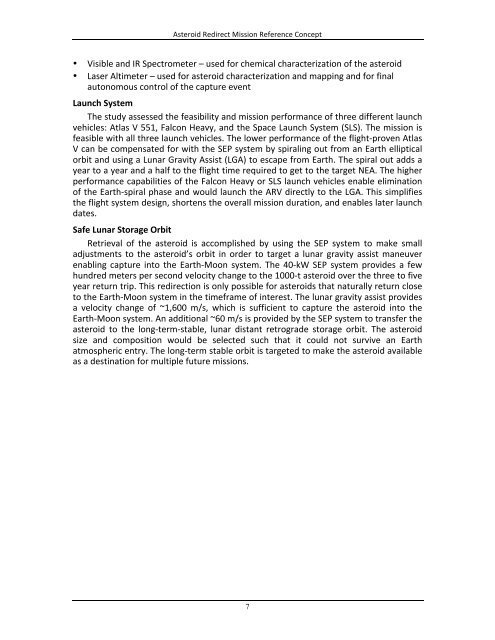Asteroid Redirect Mission Reference Concept Description - Nasa
Asteroid Redirect Mission Reference Concept Description - Nasa
Asteroid Redirect Mission Reference Concept Description - Nasa
Create successful ePaper yourself
Turn your PDF publications into a flip-book with our unique Google optimized e-Paper software.
<strong>Asteroid</strong> <strong>Redirect</strong> <strong>Mission</strong> <strong>Reference</strong> <strong>Concept</strong> <br />
• Visible and IR Spectrometer – used for chemical characterization of the asteroid <br />
• Laser Altimeter – used for asteroid characterization and mapping and for final <br />
autonomous control of the capture event <br />
Launch System <br />
The study assessed the feasibility and mission performance of three different launch <br />
vehicles: Atlas V 551, Falcon Heavy, and the Space Launch System (SLS). The mission is <br />
feasible with all three launch vehicles. The lower performance of the flight-‐proven Atlas <br />
V can be compensated for with the SEP system by spiraling out from an Earth elliptical <br />
orbit and using a Lunar Gravity Assist (LGA) to escape from Earth. The spiral out adds a <br />
year to a year and a half to the flight time required to get to the target NEA. The higher <br />
performance capabilities of the Falcon Heavy or SLS launch vehicles enable elimination <br />
of the Earth-‐spiral phase and would launch the ARV directly to the LGA. This simplifies <br />
the flight system design, shortens the overall mission duration, and enables later launch <br />
dates. <br />
Safe Lunar Storage Orbit <br />
Retrieval of the asteroid is accomplished by using the SEP system to make small <br />
adjustments to the asteroid’s orbit in order to target a lunar gravity assist maneuver <br />
enabling capture into the Earth-‐Moon system. The 40-‐kW SEP system provides a few <br />
hundred meters per second velocity change to the 1000-‐t asteroid over the three to five <br />
year return trip. This redirection is only possible for asteroids that naturally return close <br />
to the Earth-‐Moon system in the timeframe of interest. The lunar gravity assist provides <br />
a velocity change of ~1,600 m/s, which is sufficient to capture the asteroid into the <br />
Earth-‐Moon system. An additional ~60 m/s is provided by the SEP system to transfer the <br />
asteroid to the long-‐term-‐stable, lunar distant retrograde storage orbit. The asteroid <br />
size and composition would be selected such that it could not survive an Earth <br />
atmospheric entry. The long-‐term stable orbit is targeted to make the asteroid available <br />
as a destination for multiple future missions. <br />
7
















